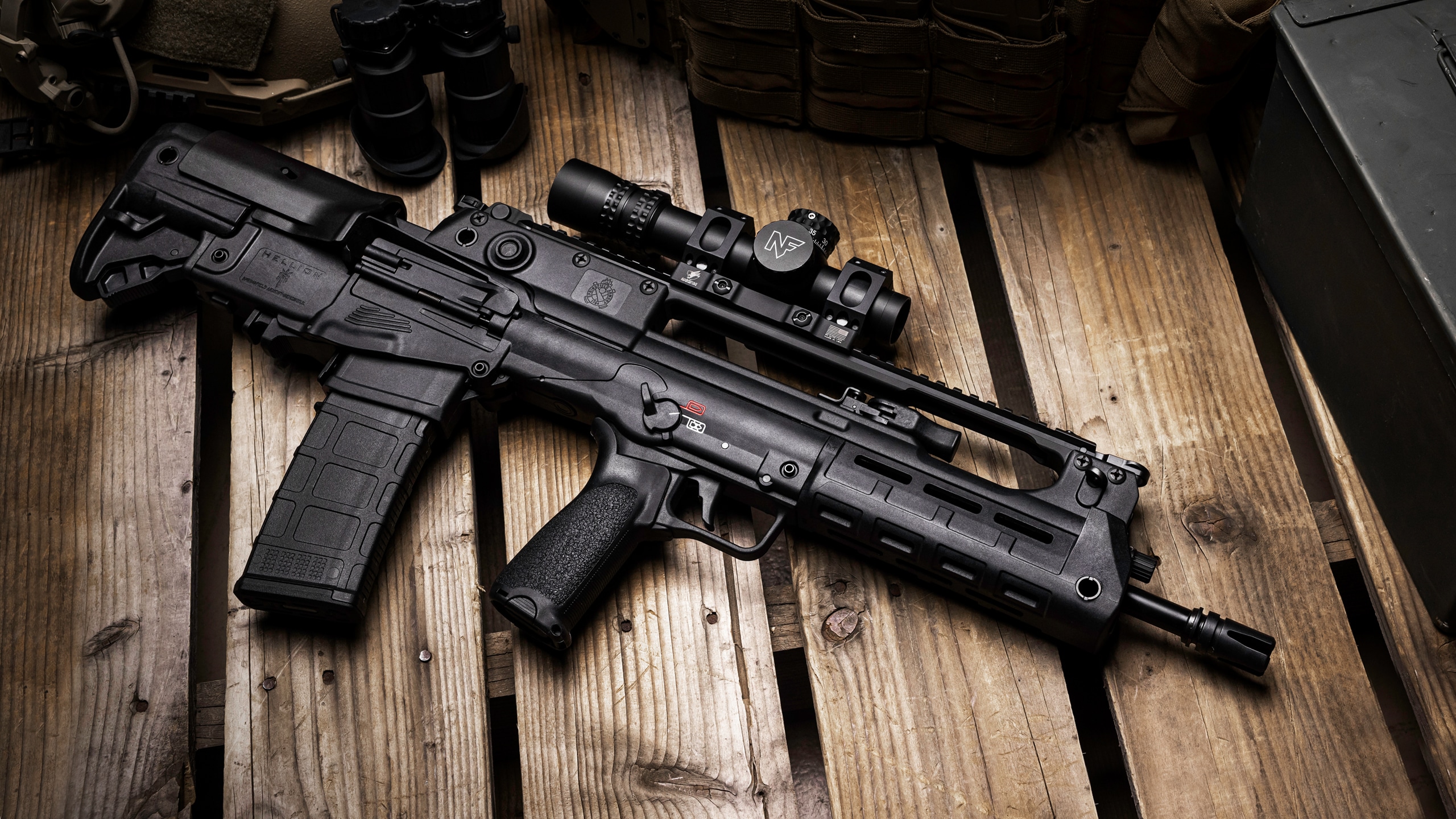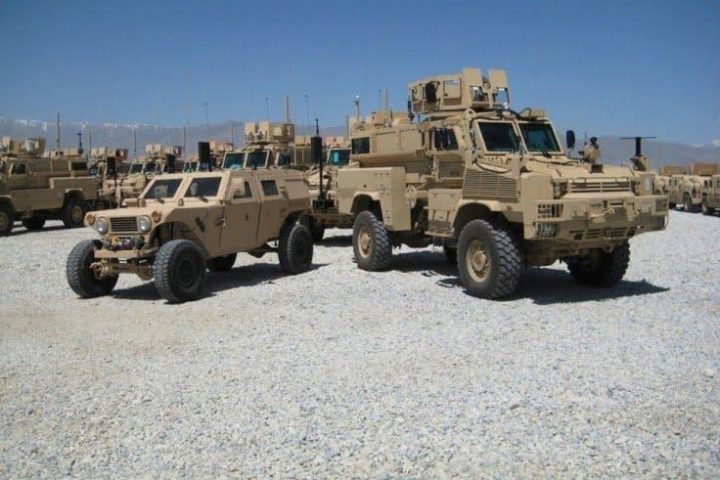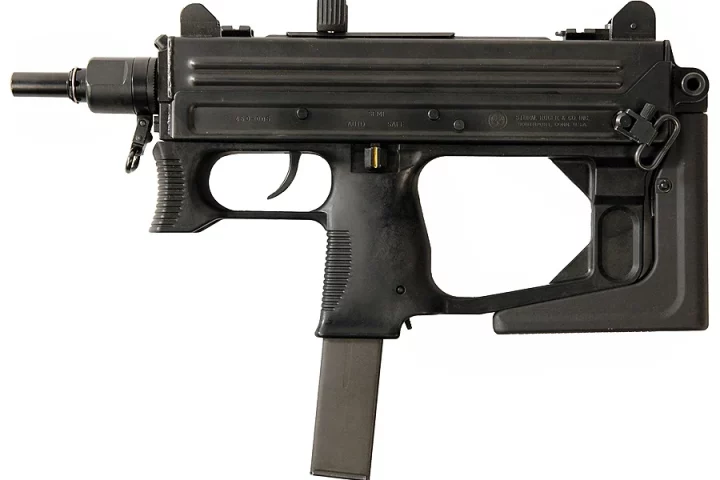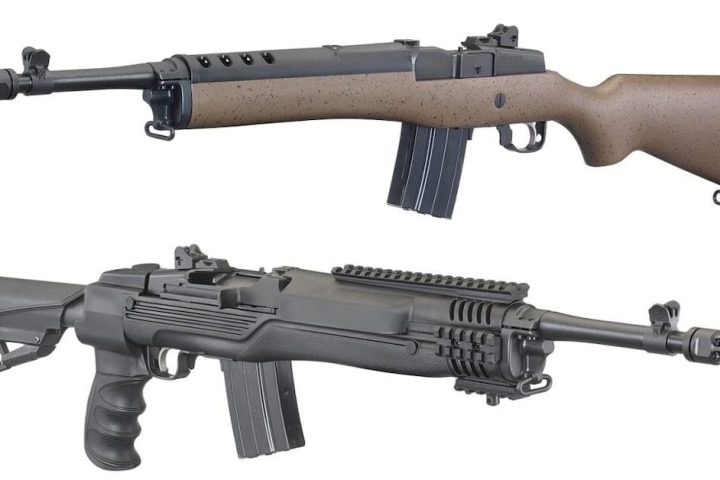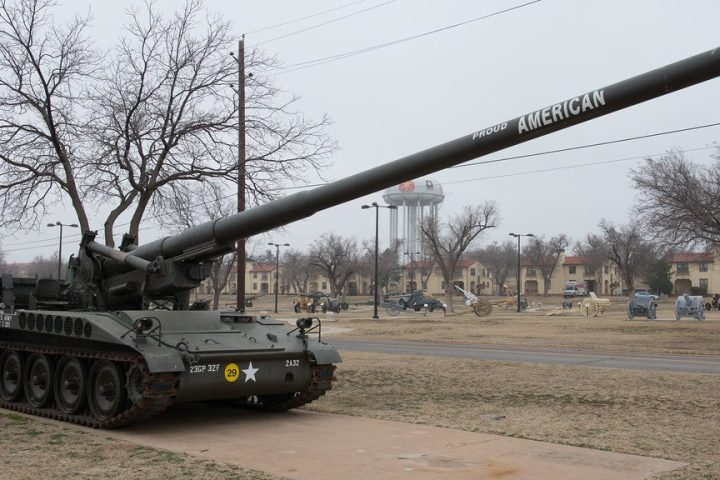After releasing the successful micro-compact pistol H11 (Hellcat), HS Produkt introduced a semi-automatic version of its Croatian military assault rifle, the VHS-2, which has the potential to become a bestseller on the US market.
Introduction
The semi-automatic VHS-2 was first presented to the public in 2013 at the Split ASDA fair, and there has been significant interest in its release ever since. Despite some initial doubts about the success of a relatively new and unproven weapon using the bullpup configuration, which was beginning to fall out of favor with military circles worldwide, the semi-automatic VHS-2 has finally arrived on the American market in 2022 as a Springfield Hellion.
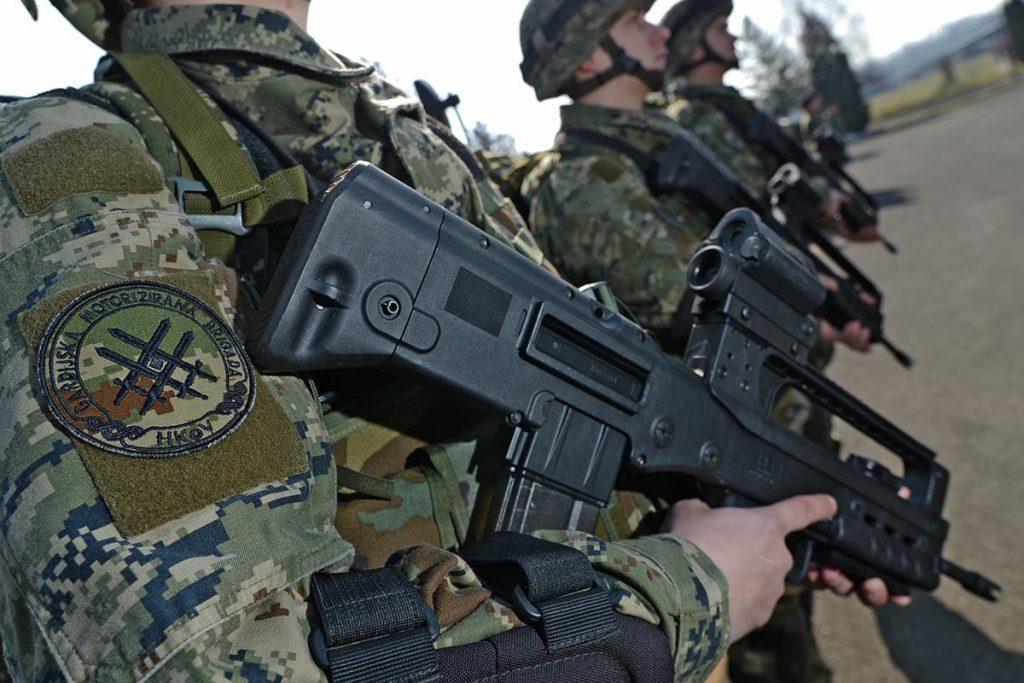
After carefully analyzing the market trends and issues with military infantry weapons, HS Produkt decided to buck the trend and continue developing the bullpup assault rifle concept instead of the classic construction. This decision was influenced by growing complaints from military circles about the low effectiveness of the 5.56 x 45 bullet, the standard caliber used by NATO. In response, the American military, as the dominant power within NATO, began looking for alternative weapons and calibers. They started by testing the existing 5.56 caliber and exploring the possibility of a new weapon and caliber.
However, introducing a new caliber and weapon would be logistically complicated and time-consuming. Therefore, HS Produkt decided to focus on improving the existing 5.56 caliber. They realized that the problem was not with the bullet itself but with the rifles, so they aimed to maximize the use of the official NATO caliber. The new rifle was designed to meet the tactical requirements of modern soldiers while also maximizing the ballistic potential of the 5.56 caliber. This allowed HS Produkt to “fill the gap” until a new weapon and caliber could be developed and officially adopted, typically taking a minimum of 20 years.
Bulk or inefficient?
Problems with the 5.56 caliber started to arise when special forces were increasingly used in warfare and were equipped with more compact weapons than the regular army. This was due to the nature of the conflicts, which were increasingly occurring in urban areas and at close distances. Most of the complaints about the effectiveness of the 5.56 caliber came from special forces and were specifically related to the effectiveness of the American M4 rifle.

The widespread use of the M4 rifle, a shorter version of the standard US military M16 rifle, only further highlighted the problems with the caliber. The interest in the M4 rifle increased after the Battle of Mogadishu in 1993, depicted in the Oscar-winning film Black Hawk Down. American Rangers complained that their M16 rifles were unwieldy in the battle conditions, while Delta Force personnel, equipped with CAR-15 rifles (the colloquial name for the shorter barreled commando version of the M16 rifle at the time) had no such complaints.
After the Battle of Mogadishu, US forces conducting the global war on terrorism increasingly adopted and used shortened versions of the M16 rifle, eventually switching completely to the M4 standard. The M4’s shorter barrel, at 368 mm (14.5 in) in the base version, had some disadvantages when used with the 5.56 caliber, as it reduced the effective range and on-target effectiveness. This was due to the specifics of modern warfare, which make longer-barreled military rifles less suitable and shorter, more compact, and lighter rifles better for fighting in confined spaces and transporting troops by modern means.

Compared to the 508 mm (20 in) barrel length of the standard M16 rifle, the M4’s barrel was significantly shorter, which did not allow the 5.56 x 45 bullet to fully “swing” and reach its ultimate ballistic potential, limiting its effectiveness on the target to possibly 150 m. This was especially evident in Afghanistan when rebels often continued combat operations despite being affected by the bullet due to their specific clothing (wide robes). The reduced exit velocity at the mouth of the barrel reduced the kinetic energy of the impact on the target, and the light grain of the bullet often changed direction when hitting even the smallest and softest of obstacles. This is why complaints about the 5.56 caliber’s effectiveness have become more frequent.
Defying the trend
HS Produkt correctly identified the problem and offered a solution in the form of the VHS-2 bullpup assault rifle, which defied the trend of returning to classic designs for military assault rifles. The main idea behind the VHS rifle was to create a compact weapon suitable for combat in cramped urban environments and for use in all types of vehicles, while also maximizing the ballistic potential of the official 5.56 NATO caliber.
The bullpup construction made the VHS rifle different from previous weapons used by the Croatian army and police. The shutter, trigger mechanism (excluding the trigger and portable “lever”), and magazine (in most cases) are located behind the handle, rather than in front of it as in classic designs. Bullpup rifles can be easily recognized by the magazine, which is located behind the handle, while classic designs have the magazine in front of the handle.
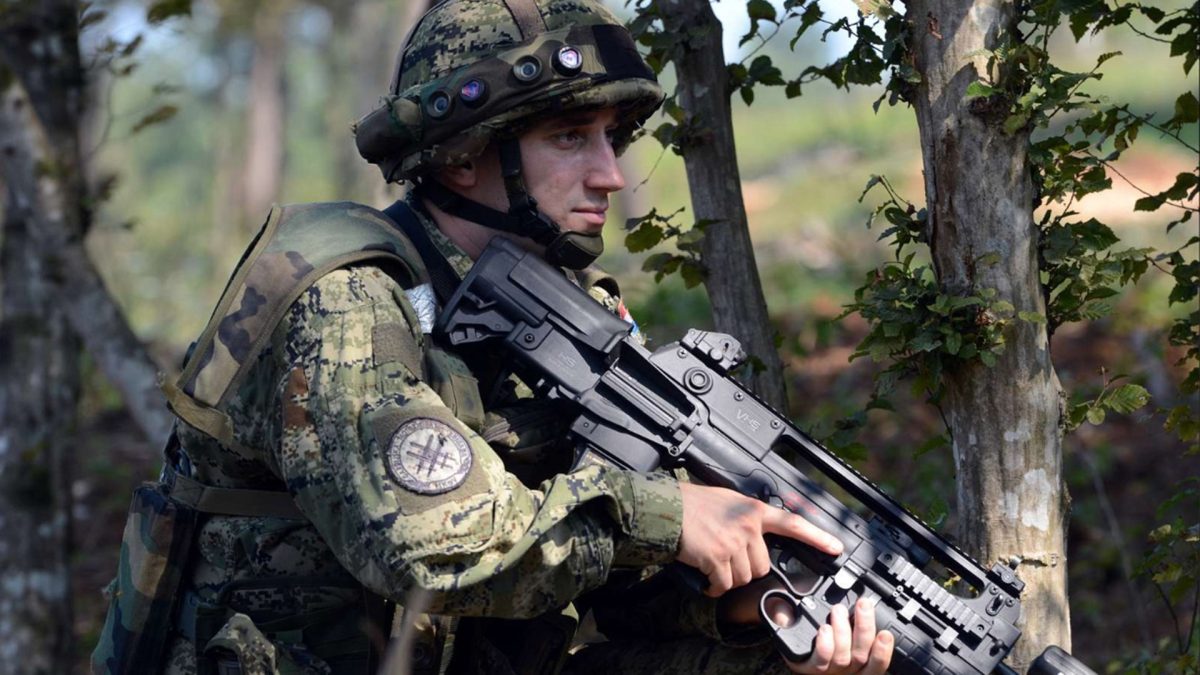
HS Produkt’s decision has proven to be a good one, as the VHS-2 rifle has been adopted as the official assault rifle of the Croatian army and police, as well as the armies of Iraq, Cameroon (special unit B.I.R.), Togo, Albanian special police units, and some special police units in Bosnia and Herzegovina (Livno, Zenica). This success is noteworthy considering that bullpup arms were at their peak in the 1970s and 1980s.
Despite initial skepticism from some professional circles, HS Produkt succeeded with its vision, and the VHS-2 rifle, along with the Israeli Tavor, is one of only a few bullpup weapons that has gained a significant share of the military market in recent years. It is also worth noting that the VHS-2 rifle (in the “French” F version) was among the thirty weapon designs that made it to the finals of the selection for a new assault rifle for the French army, where it took second place behind the German HK 416 rifle.
Actual concept
The bullpup design has proven to be more than just a trend from the 1970s fashion industry. It is still a relevant concept, as evidenced by one of the two candidates for the official light infantry weapon of the US military under the Next Generation Squad Weapon (NGSW) program. The group of companies True Velocity, General Dynamics, and Beretta has developed a bullpup platform called RM277, which includes a rifle and light machine gun that use 6.8 mm caliber ammunition with a composite material sleeve. The main advantage of this design is a longer barrel that allows for an increase in the initial speed of the fired projectile while still maintaining the same overall length of the weapon.
The NGSW program aims to improve the effectiveness of infantry weapons while maintaining or reducing their overall mass and size to increase the operability and mobility of soldiers. The bullpup design enables a satisfactory barrel length on a compact platform, which is a key solution to this goal.
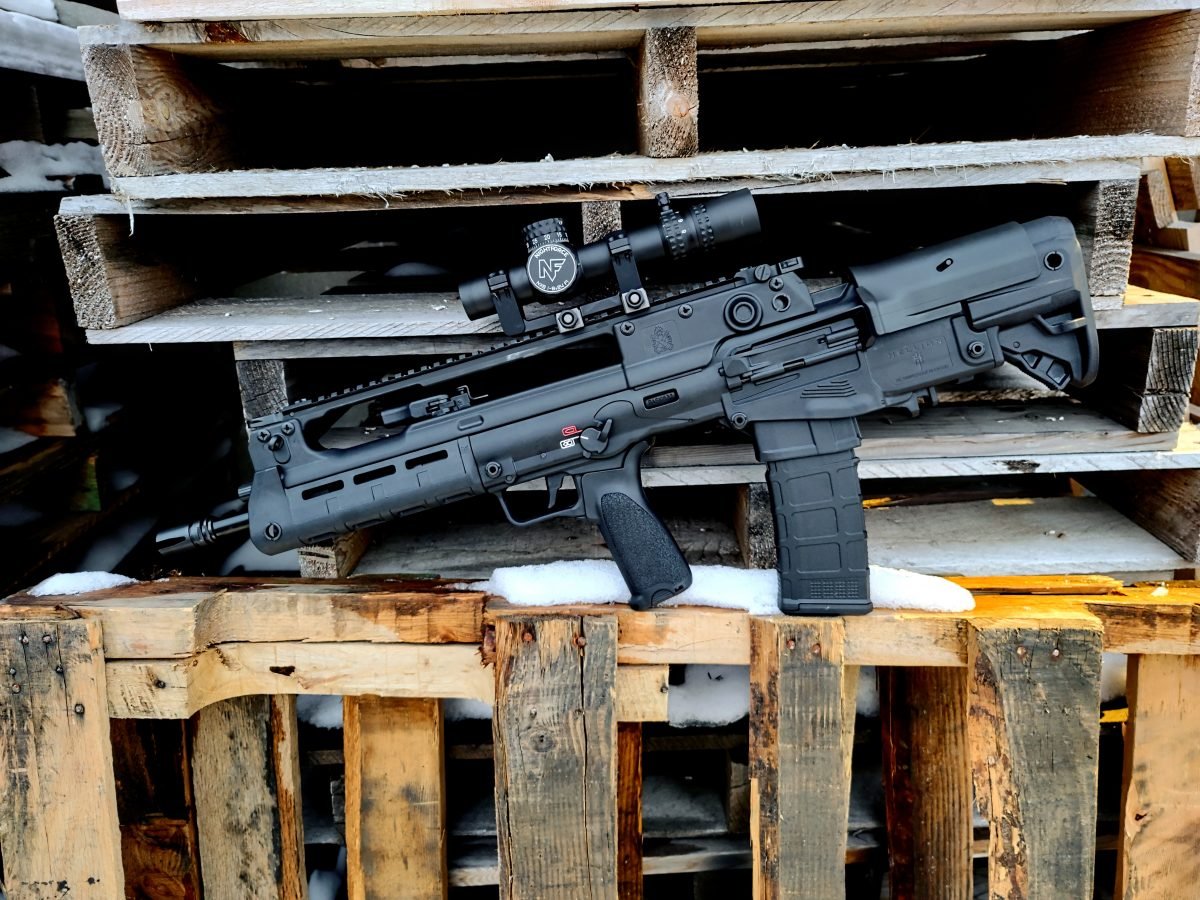
In recent years, bullpup weapons have become more widely available in the military, police, and civilian markets. In addition to assault rifles, sniper rifles, and combat shotguns, there are even pistol conversion kits that transform classic pistols into bullpup weapons. One example is the META Tactical APEX Series Carbine Conversion Kit, which was introduced at the recent Shot Show in Las Vegas. The civilian version of the VHS-2 rifle has also garnered significant public interest due to its features, such as full ambidextrousness, the ability to shoot from both shoulders, modularity, compactness, and a futuristic Sci-Fi design.
Same, but different
The Hellion rifle is optimized for the 5.56×45 NATO standard SS109 caliber, which means that its rifling has a 1:7 twist pitch designed to stabilize the 62-grain mass. Its barrel is 410 mm (just over 16 inches) long, and its total length with the stock folded is 708 mm. It is lighter than the VHS-2 military rifle, weighing 3.62 kg compared to the VHS-2’s 3.75 kg.
Despite their many similarities and interchangeable parts, there are significant differences between the Hellion and the VHS-2. The Hellion is a semi-automatic version of the military rifle and uses a different design for its gas block and assembly, which is not interchangeable with the VHS-2. The Hellion’s gas cylinder, piston, and spring are smaller than the military model’s.
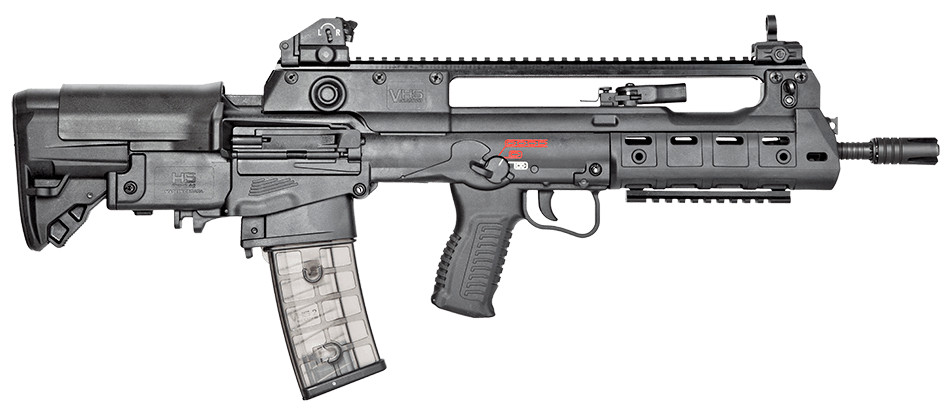
Its piston and spring are shorter and less powerful, and its gas block has a valve with two positions: one for normal semi-automatic operation and one for operation with a silencer. As a result of these design changes, the Hellion’s carrying handle and target platform mounts, as well as its top of the shutter support and return spring, are also different from those of the military model. These differences make the Hellion easier to load and unload.
Solution from the “French” version
The Hellion rifle’s trigger mechanism is a separate module, like the military model’s. However, it is a semi-automatic mechanism that does not allow for rapid fire. It is also made of metal, rather than polymer like the military model’s trigger, and is modeled after the “French” (F) model of the VHS-2 rifle. This design helps to eliminate the drag effect that is common with the military model’s trigger, which is flat rather than oval.
As a result, the Hellion’s trigger is easier to feel and pull, allowing the shooter to bring it to the “knee” during firing and making it easier to follow the shot and reset the trigger. The fire selector is adapted for semi-automatic operation and has two positions: “locked” and “unlocked”, which is the firing position.
The Hellion’s shutter also has an inertial safety for the firing pin, another feature of the F model of the VHS-2 rifle. This theoretically prevents unintended firing due to the weapon being dropped while cocked and ready to fire. The rifle is made of high-quality polymer coatings and stocks and grips held together by metal shafts (captive pins). These are not removable from the rifle’s body, which is a useful feature as it prevents the loss of small parts when disassembling and assembling the weapon.
The Hellion has been adapted for the civilian market and includes cosmetic changes, compatibility with the NATO STANAG 4694 aiming platform and the M1913 Picatinny standard. Its carry handle, located at 12 o’clock, is equipped with a front barrel cover with three M-LOK slots at 3, 6, and 9 o’clock. M-LOK is currently the most popular standard for installing additional equipment, and factory equipment with Picatinny rails is becoming less common. Most manufacturers are now using alternative solutions like M-LOK.
Misinformation about magazines
To allow users to customize the Hellion rifle, its grip is detachable, and any AR-15 grip can be installed. This is a good solution considering the popularity and excellent ergonomics of AR-15 grips, as well as the familiarity American customers have with them. The grip can be easily removed by unscrewing the Allen screw located on the rifle’s body with a key through the hollow body of the grip. The grip on the Hellion differs in shape, geometry, and anti-slip roughness from the grip on the military model.
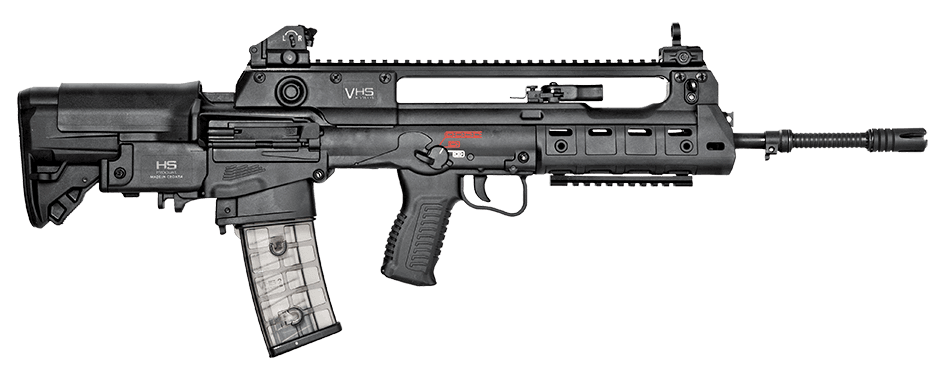
HS Produkt has also installed three QD slots on the left and right sides of the rifle for different sling attachment options. These slots are located on the front lining of the barrel, in the rear part of the carrying handle under the rear sight, and on the stock. In addition to the standard four links, this allows for ten positions where the rifle belt can be placed.
The Hellion is supplied with a magazine insert designed to accept AR15/M16/M4 magazines for the American market, as these magazines are very popular and widely used. However, HS Produkt also plans to offer an option for the rest of the market with an insert for original VHS-2 rifle magazines that comply with the regulations of the end user’s country. It is possible to use either type of magazine by simply replacing the guide with the appropriate one for the desired magazine type.
It is worth noting that there is misinformation circulating on American portals and YouTube channels that the VHS-2 rifle uses magazines from the German Heckler & Koch G36 assault rifle. This is not true. HS Produkt has developed its original magazines, which are not the same as G36 rifle magazines. The containers may be visually similar, transparent, and have clips for connecting, but they are not the same. This misinformation was likely spread through copy-pasting and became a fake fact.


